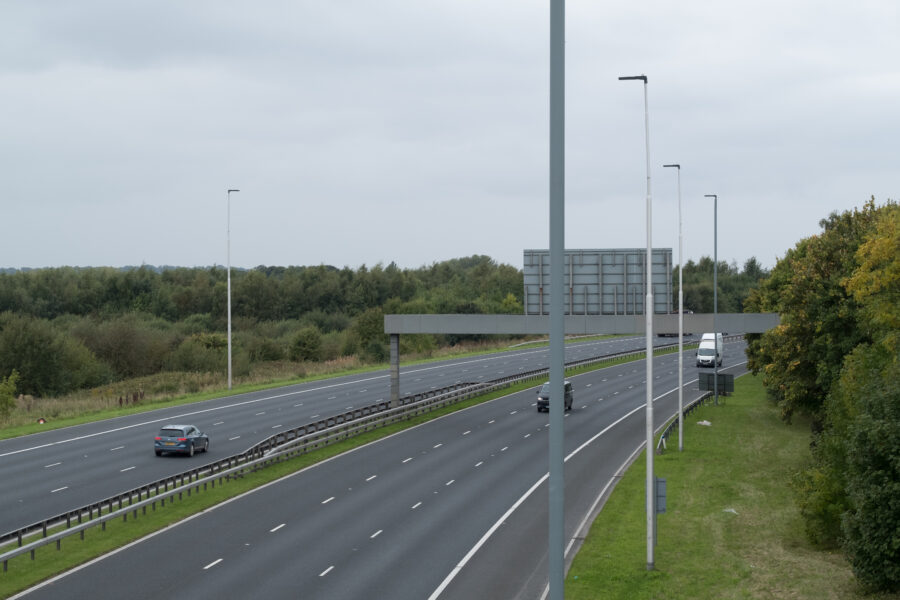Crown Highways has recently delivered an innovative major Lighting scheme Highways England in Area 10, with the installation of 22 new lighting columns which incorporate an innovative CU Phosco vibration monitoring system built in the column. The scheme is located on the M62 Rakewood Viaduct between junctions 21 and 22.
This, amidst several challenges including the COVID-19 pandemic outbreak.
This lighting scheme was very high profile for Highways England as the lighting at this location had been subjected to previous media coverage. The location has experienced two instances where columns have been cut down under emergency situations due to them physically snapping off and falling into the carriageway.
The first instance was central reservation columns experiencing such high gusts of wind and funnelling effects the columns were snapping off. The second instance, the weather was heavy winds, with both snow and sleet. Video footage at the time showed verge lighting columns oscillating rapidly and then snapping off approximately 6 to 8 meters above ground and falling onto the verge.
Therefore, the scheme was used as a flagship for a vibration monitoring system designed by CU Phosco which monitors the movement and vibration of the column. This innovative technology can now detect the characteristics of a column and records their performance data for future analysis which reduces the possibility of further incidents occurring on this stretch of road.
This was a great project to be involved in and it's always great to see new technology added to our network. The teams within Area constraints and safe operating procedures around COVID-19 we should all be p10 have really pulled together to ensure this project was delivered safely and on time. Given the recentroud to have a delivered an essential scheme in the region.
Mike Dale
Managing Director, Crown Highways
The history of the previously problematic location showcases why this scheme has been so high profile and been subjected to extensive design parameters for the column design and approval.
The new columns have been subjected to a lengthy process of design to achieve Approval in Principle (AIP) and CAT 1 standards and check certification. This AIP process takes into consideration a plethora of data to ensure the column are safe for use on the Highways England network.
CU Phosco carried out wind flow analysis based on the site topography looking at the impact of the altitude and topography on the design wind speed to be used for the lighting columns. They also completed vibration analysis on the lighting columns to establish the susceptibility to wind-induced vibration; structural design conditions that are not specifically covered by the British Standard for lighting columns, BS EN 40.
CU Phosco highlighted that the original columns were likely to have been susceptible to wind-induced vibration which probably led to resonant vibration causing the early failure by fatigue within the timescales seen on site. CU Phosco designed and supplied a bespoke lighting column using their fatigue-resistant Tapered Tubular column solution that minimised the susceptibility to the wind-induced, resonant vibration. they provided further mitigation against vibration through the design and supply of a bespoke structural damping solution that absorbs the energy built up within the lighting column that causes resonance.
Within the scheme, there were two new feeder pillars installed, 8000m of new electrical cable and 4000m of ducting laid (also giving capacity for any future schemes in the region).
We are very happy with the delivery, support, collaboration and communication of the teams throughout this entire scheme.
Mike Jones
Project Manager, Highways England
COLLBORATION IS KEY
The complex project was managed by the Crown Highways Lighting Framework Manager Mark Robinson he ensured the scheme was delivered collaboratively using the wider Crown Highways, Highways England, Amey Consulting and CU Phosco. Collaborative working between all these partners has enabled this scheme to be installed ahead of schedule and to a high standard.
Whilst the scheme was in progress we collaborated further to facilitate some additional scheme work in and around M62 J21-22, these included:
- Lining works repairs/replacements – Highways England Area 10
- Bridge joint repairs and essential maintenance – Highways England Area 10
- Fencing works – Amey Consulting
- Facilitate drainage repairs – Amey Consulting
- Replacement of roadside technology cables following CDR reports – Crown Highways
- Installation of a new CMS lighting system – Crown Highways / CU Phosco / Signify
It was great to work with Crown Highways who planned, coordinated and installed the columns on this project for Highways England delivering these market-leading innovative solution on time and to budget
David Lodge
Technical Director, CU Phosco
DELIVERY AHEAD OF SCHEDULE
Due to the lead times for the new columns and with the added difficulties of getting the AIP signed off, the program was always going to be challenging. Add to this the unexpected COVID 19 difficulties the team on-site worked together to ensure the scheme was completed ahead of schedule and before year-end.




